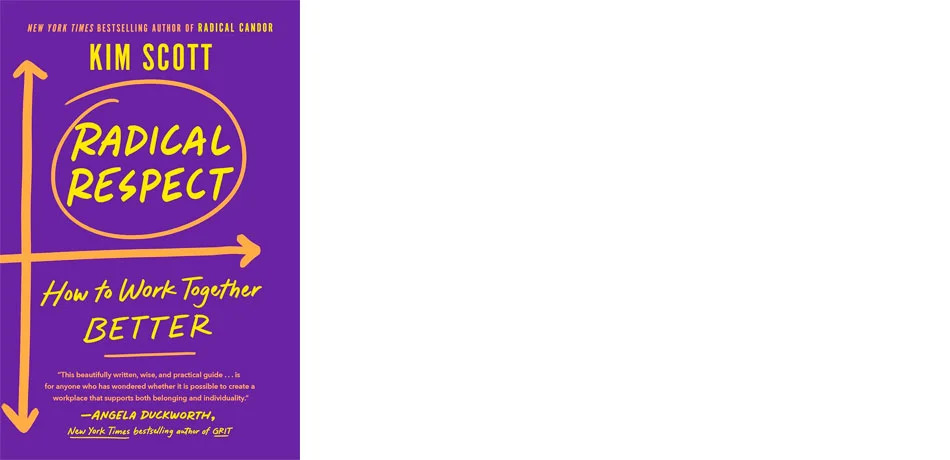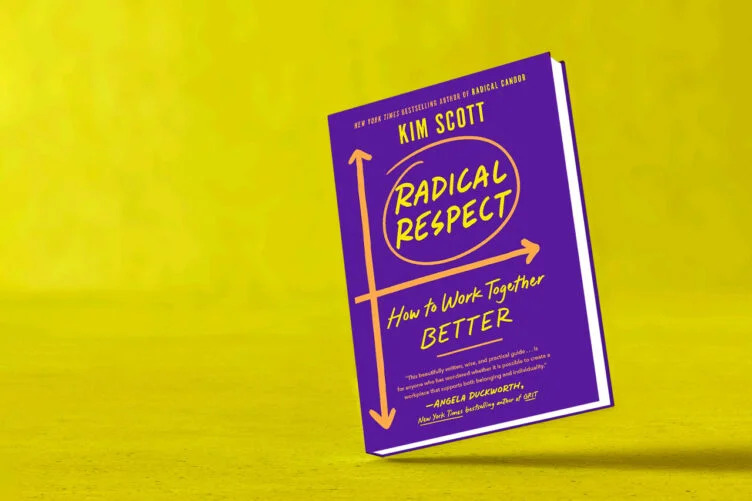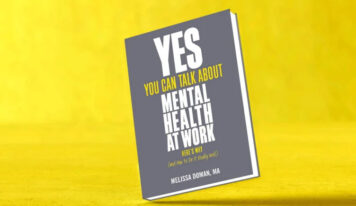Organizations that foster collaboration and respect individual differences are more successful and joyful places to work. A guide to help create a workplace where everyone can thrive.
Author: Kim Scott
Key Ideas:
- The book offers practical suggestions and tactics for addressing different forms of bias and bullying without falling into denial. The goal is to build an inclusive work environment.
- Leaders play an important role in addressing these issues by consciously creating norms and systems that promote respect and collaboration—but they can’t do it alone; everyone’s participation is needed.
- An advocate’s responsibility is to intervene in situations involving bias or bullying in the workplace. They can help a victim feel less alone and provide clear feedback to those causing harm.
- A person who has been targeted may choose to remain silent, but it’s worth resisting this pattern, responding, breaking the cycle of anger, and cultivating advocates.
- Those who cause harm should become aware of their actions and make amends.
- Management systems designed explicitly to optimize collaboration rather than coercion, and to honor individuality instead of demanding conformity, lead to Radical Respect, fairness, innovation, and productivity.
- Checks and balances and measuring what matters can make management systems fairer and more successful across all stages of an employee’s professional life.
- When facing discrimination or harassment, seek to document it, build solidarity, and find your nearest exit. Possible actions include speaking directly to the aggressor, reporting the incident to HR, taking legal action, or sharing your story publicly.
- Leaders are responsible for clearly communicating a culture of consent, making it easy and safe to report violations, and giving people a chance to learn (but not too many chances).
About the Author:
Kim Scott has worked at major tech companies such as Twitter, Dropbox, and Qualtrics. She was part of Apple University and, before that, led teams at Google. She is also the author of Radical Candor: Be a Kick-Ass Boss Without Losing Your Humanity.
Introduction: We Can Only Solve Problems If We’re Willing to Notice Them
Kim Scott explains that feedback from her previous book, Radical Candor, motivated her to write this new one. “I realized I had treated different forms of bias and bullying as if they were the same, which hindered effective responses. After all, different problems require different solutions.”
So, she decided to describe these problems and explore how to fix them. “Awareness is the first step toward change. But awareness without action quickly leads to despair.” The book offers practical, tactical suggestions for addressing these issues without denial. The aim is to build a better work culture.
Our actions will depend on our roles in each situation: we may be a leader, an advocate/bystander, the person harmed, or the person causing harm. “We must do more than merely tolerate one another if we want to optimize collaboration and honor individuality. We can work better together—even with joy.”
Part 1: Everyone Has a Role to Play
1 – A Framework for Success
What is Radical Respect? The definition of respect used here is consideration for the feelings, wishes, rights, and traditions of others. This kind of respect is something we owe everyone; it is not something that must be earned. Therefore, the respect referenced in the book’s title exists in workplaces that do two things at once: optimize for collaboration rather than coercion and honor individuality instead of demanding conformity.
Why is it so hard to see these two practices at work? Often, our biases lead us to expect conformity, even unconsciously. When you add power and management systems on top of that, these expectations are baked into whom we hire, promote, and fire. Unconscious bias enables discrimination.
Scott explains that leaders have an essential role in solving these problems by consciously creating norms and systems that support respect and collaboration—but they can’t do it alone; everyone must participate.
The book proposes that the first step is naming the problems, so they can be addressed in distinct ways: bias (intentional or not), bullying, discrimination, harassment, and physical violations.
Unintentional bias, for example, can be addressed with “I” statements to share your perspective: “I don’t work here,” or “I don’t think you meant that the way it came across to me.”
Intentional bias can be confronted with “that” statements, such as “that’s against the law” or “that’s an HR policy violation.” Bullying, on the other hand, should be addressed with “you” statements like: “What’s going on with you?” or “You need to stop talking to me like that.”
2 – How Leaders Can Promote a Culture of Respect
Scott argues that leaders don’t have to choose between collective results and individual uniqueness—they rely on each other. Bias and bullying harm both individual and collective efforts. These behaviors lead to unethical conduct, lowered standards, lack of accountability, and poor collaboration.
Leaders are responsible for preventing such issues, moving past the idea that doing so is a distraction from their “real” work. Increasingly, leaders understand that achieving results is difficult without first creating a reasonable and inclusive workplace.
To address unintentional bias, it’s crucial to listen when someone says certain language is uncomfortable. Likewise, be kind and clear when addressing language that bothers you. Good communication is measured by the listener, not the speaker. Creating a culture where people can respectfully correct one another is a step forward.
Handling intentional bias is trickier. A strong leadership move is to create space for the team to discuss real-life cases and how they could be handled.
Bullying must be recognized and stopped. Leaders are responsible for creating consequences for such behavior and for preventing certain individuals—often from dominant groups—from monopolizing meetings or spreading misinformation.
Leaders must also give a voice to quieter team members, block superstar behavior, and encourage everyone to participate.
Tips for building a feedback culture include: ask for feedback from all direct reports; don’t play favorites; don’t let bias or intimidation distort feedback; avoid micromanaging or absentee management; and beware of backhanded compliments or subtly racist praise.
3 – Be an Advocate, Not a Silent Bystander
An advocate’s job is to step in during instances of bias or bullying. They help victims feel less isolated and provide clear feedback to those causing harm. They lead by example, encouraging others to do the same and creating a virtuous circle.
Advocates have advantages: they’re often more numerous, they’re not the victims, and they can build solidarity through differences and shared identities. When giving feedback to an aggressor, avoid attacking their personality or character.
Instead, clearly express your thoughts and try to understand that a person’s biased behavior doesn’t define their entire self. They’re not your enemy. You can disagree and still work together.
In bullying situations, consider being direct; create a distraction, such as stepping between people; ask for help; follow up with the aggressor later; and document what happened.
Be mindful of your own conduct when intervening—avoid moral superiority, bullying the bully, downplaying the victim’s experience, or playing the “white savior” in cases of racism.
To avoid reinforcing the very injustice you’re trying to address, be clear about your intentions. This is not about showing virtue, nor does it mean the person you’re helping can’t stand up for themselves. It’s about challenging a broken system and helping create a workplace where everyone can thrive.
4 – What to Say When You Don’t Know What to Say
It’s up to the person being targeted to decide how to respond. You may choose silence to stay focused on your goals rather than “educating” someone. But sometimes it’s worth responding, especially to unintentional bias. An “I” statement is a generous way to address unconscious bias. The goal is to help the person learn, not to shame them.
Benefits of responding include affirming your own identity, rejecting the biased message, improving your work environment, building a virtuous circle, and strengthening your relationships.
Intentional bias is more delicate. Confronting it helps draw a line between someone’s right to believe what they want and your right not to have that belief imposed on you. In bullying situations, respond with a “you” statement. It’s a kindness—not punishment, but accountability.
In every case, resist staying silent, break the cycle of anger, and nurture advocates. The more trusted colleagues we have, the stronger our professional relationships—and the better we can perform.
5 – Be Part of the Solution, Not the Problem
If you’ve caused harm, it’s your responsibility to acknowledge it and make it right. Educate yourself (don’t ask the person you hurt to educate you), publicly admit your mistake when possible, accept the consequences, make amends, apologize, and commit to permanent change.
For unintentional bias: find people who will be honest with you; question false consistencies; recognize how “small” actions can have big effects; manage your defensiveness and be persistent.
In bullying situations: reflect on your behavior. If you’re mocking or challenging someone for not fitting into arbitrary norms, stop and ask why. Recall past patterns.
If you want to change, adopt a growth mindset; focus on impact, not intent; measure communication by the listener, not the speaker; avoid telling others how they “should” be; and know how to apologize—or when not to.
An apology doesn’t solve the problem. In fact, repeated apologies without action can become like salt in a wound.
Part 2 – Don’t Let Power Ruin Everything
6 – Design Principles for Radical Respect
Being a good person isn’t enough for a leader. They must design good management systems. When those systems are built to optimize collaboration—not coercion—and honor individuality—not demand conformity—they result in Radical Respect and the justice, innovation, and productivity that come with it.
To do that, power must be limited. Excessive power can lead to intentional or unconscious bias, bullying, verbal, psychological, and physical harassment.
To design a collaborative hierarchy, implement enough checks and balances so those in authority can be held accountable, are less likely to be corrupted, and can’t rob others of the ability to do excellent work.
Another key design principle is measuring what matters. You’ll be more successful hiring and retaining the right people when you quantify bias in your company—and it may be illegal not to. Metrics should be embedded in all management processes. Focus on solutions, not excuses.
Leaders must stop ignoring exclusion in their teams and avoid brutal inefficiency that enables coercion, intimidation, and harassment. If systems reflect and reinforce societal injustice, they must be changed. If a leader can’t change the system, they should step down.
7 – Apply Design Principles to Management Systems
Checks and balances and measuring what matters can make management systems fairer and more effective at every stage of an employee’s career. These principles can be applied in areas such as compensation, performance management, coaching and mentorship, terminations, organizational design, and hiring.
To ensure your compensation system is fair, it should be built on principles and your pay data should be organized by demographic group. Consider adding a page to your website that outlines pay ranges and benefits by role. This approach saves time and emotional energy for you and all job candidates.
When managing performance, ensure promotions are accessible to everyone, not just those from privileged groups. Create promotion committees that review employee performance and make decisions—managers contribute input but aren’t the sole decision-makers.
Coaching and mentorship are just as important to career growth as formal systems. Employees from historically marginalized groups are less likely to receive this kind of support. If you’re a mentor, make an effort to work with people who are different from you. Also, avoid scheduling mentoring meetings in exclusive spaces like nightclubs or private clubs.
It’s important to examine why people are leaving the company—especially if it’s due to bias or bullying. Another key point is to prepare the organization for new hires. Diverse hiring committees are particularly effective here.
Consider evaluating skills, not identity; be explicit about hiring criteria; seek culture add, not culture fit; and challenge biased comparisons within the hiring committee.
8 – Create Virtuous Circles, Avoid Vicious Cycles
How can we build a virtuous circle that leads to systemic justice in the workplace? First, we must understand that it’s attitudes, behaviors, and their dynamics that can either support or undermine collaboration and respect.
The dynamic of conformity, for example, offers the appearance of rationality, civility, and politeness—but excludes people in irrational ways that can be as damaging long-term as violence. The dynamic of coercion is more brutal. When bias, intimidation, and harassment are tolerated, they often escalate to physical violence.
Even if we’ve never committed violence and don’t consider ourselves capable of it, we must recognize how our words can reflect and reinforce patterns of harm. This is difficult, and many people are reluctant to acknowledge this dynamic.
9 – Speak Truth to Power Without Destroying Your Career
Before confronting discrimination or harassment, try to document it, build solidarity, and locate the nearest exit. Then decide how to handle the situation: speak directly to the aggressor, report the case to HR, take legal action, or go public with your story.
To document what happens, write down the time and place, what was said or done, who was involved, and who witnessed it. You don’t have to be perfect—this is just the first step. You may never need it. Save files to your personal device or cloud, not a work computer.
If you feel isolated, seek allies. Ask for advice or help from more experienced colleagues. They might help you change teams, get promoted, get introduced to a new company, or simply report the issue to HR. As a last resort, consider looking for another job.
Thanks to movements like Me Too, those who speak out about harassment receive more support and solidarity than in the past. Still, we must pay attention to whose stories get more attention—white women, for instance, often receive more visibility than Black women.
When telling your story, be sure to extend solidarity to others who are also experiencing discrimination or harassment but don’t have the same level of access or privilege that you do.
10 – Reinforce a Culture of Consent
It’s impossible to create overly rigid rules for behavior at work, but it is possible to set protective boundaries to ensure everyone understands that their desires or beliefs cannot be imposed on others. This includes addressing unwanted physical contact; consensual contact between peers; abuse in power-imbalanced relationships; and violence, alcohol, or drug use in the workplace.
Some people do not want to be touched at all at work. That’s their right. It doesn’t matter what most people think is “appropriate.” What matters is how the person being touched feels. The goal isn’t to ban all handshakes or hugs because they might make some people uncomfortable—it’s to honor each individual’s boundaries rather than expecting them to adapt to others.
Leaders are responsible for clearly communicating their organization’s culture of consent, making it easy and safe to report violations, and giving people a chance to learn—but not unlimited chances.
Romantic relationships at work should be handled carefully. They don’t need to be banned, but they must follow rules. Relationships involving power imbalances—for example, between a manager and a direct report—can create problems and are usually discouraged. If such a relationship does happen, the person in the more senior position should be the one to leave the company.
Cases of violence must be met with appropriate severity, including contacting law enforcement. Leaders should be alert to this during hiring—seek references that can speak to a candidate’s past behavior. Ban alcohol and drug use at work. A culture of heavy drinking often creates a hostile workplace, especially for historically marginalized groups, particularly women.
11 – A Letter to My Younger Self—and Her Boss
Scott shares that her first job after college was “deeply disorienting.” She faced pay discrimination, earning significantly less than peers in the same role. She experienced intimidation and bias when speaking to two managers about it, and was later subjected to verbal harassment and physical violence by other team members.
The management systems her leaders had built failed and ended up reinforcing harmful dynamics. That’s why Scott emphasizes that being a good person isn’t enough for someone in a leadership role.
Leaders must design systems to prevent these issues and ensure that employees have a kind of “justice pull cord” they can activate when bias, bullying, discrimination, harassment, or physical violations occur—despite leaders’ best efforts to prevent them.
12 – Put Some Wins on the Board
Reaching a workplace culture of Radical Respect is a journey. It must be pursued and sustained over time. All of us need to be proactive in our intention not to cause harm. Scott sees her time at Google in 2004 as a personal win for respect.
“In an environment where I felt safe, comfortable, and equal to my colleagues, I did some of the best work of my life. I gave everything I had to that job. My team and I fulfilled my promise to ‘defy the law of large numbers.’ We increased revenue tenfold while reducing costs. We built a fast-growing, extremely profitable business. And we had a lot of fun doing it, forming relationships that last to this day. I loved my job and my team; we accomplished so much together.”

TECHNICAL INFORMATION:
Title: Radical Respect – How to Work Together Better
Author: Kim Scott
Publisher: St. Martin’s Griffin
Summary by: Fernanda Nogueira
Edited by: Monica Miglio Pedrosa
![[Experience Club] US [Experience Club] US](https://experienceclubus.com/wp-content/uploads/2021/03/laksdh.png)










![[Experience Club] US [Experience Club] US](https://experienceclubus.com/wp-content/uploads/2021/03/logos_EXP_US-3.png)







